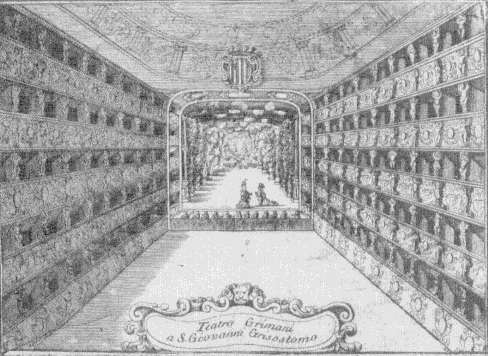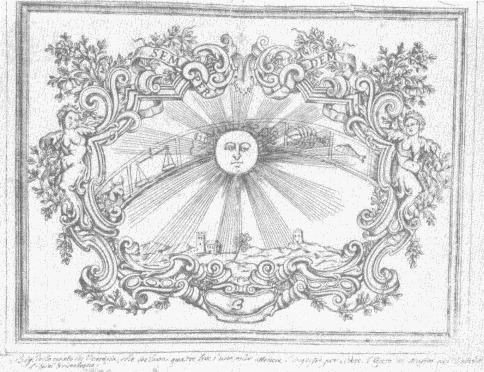Il volgo tumultuario
The conditions that contributed to the fall of Orpheus in 1673 were reflected in other developments as well. In the very next year, the two-theater monopoly that had dominated operatic activities for more than a decade was broken. Newly revitalized, the Teatro S. Moisè, which had unsuccessfully threatened the monopoly some years earlier (in 1666), entered into competition with SS. Giovanni e Paolo and S. Salvatore. And the S. Moisè's new manager, Francesco Santurini, incurred the enmity of his competitors by reducing the price of admission. The change was lamented by Ivanovich, among others.[6] He regarded it as undermining the level of operatic entertainment, and alluded to it passionately several times during the course of his "Memorie teatrail" before devoting an entire chapter to a discussion of its deleterious effects.[7] In Ivanovich's view, reduced ticket prices, besides limiting the funds available for operatic productions and therefore diminishing their grandeur, lowered the social level of the audience to include ignorant and disruptive crowds.[8]
Santurini's move, strongly opposed by the other theater managements, met with great popular success.[9] Despite the notoriously small size of S. Moisè, the price reduction was so profitable that it encouraged him to seek the usual patrician support for the construction of a new, larger theater, where he could expand the practice. The first new opera house in nearly three decades, the Teatro S. Angelo opened for business in 1677.[10] The new theater was still relatively small, but its modern facilities and central location combined with the reduced price of admission attracted a large audience, forcing the competing theaters to lower their prices as well—S. Salvatore in 1677, SS. Giovanni e Paolo in 1680.[11]
[6] This was big operatic news, as indicated by the fact that it is mentioned repeatedly in reports from Venice to the duke of Brunswick (Appendix IIIB. 12 and 16b). The other theaters evidently felt the competition, as indicated by a remark in the avviso of 30 January 1683 (Appendix IIIC.3).
[7] For earlier allusions, some of them quite thinly veiled, see Appendix II.61, m, and v.
[8] See Appendix II.6x.
[9] As reported in several letters from Massi to the duke of Brunswick; see Appendix IIIB. 14 and 15.
[10] Until 1677 the Teatro S. Apollinare, constructed in 1650, had been the newest opera house. The Teatro S. Samuele had been constructed more recently, in 1655, but for the purpose of spoken drama rather than opera. See Mangini, I teatri di Venezia , 70.
[11] The whole story is related by Ivanovich (Appendix II.6x, y): "Profits at the door, the basis of the business investment, instead of growing are diminishing, evidently endangering the continuation of this noble entertainment. The low price eliminates the possibility of maintaining the customary splendor, allows entry to the ignorant and riotous multi-tudes, and causes those virtuous works performed no less for delight than for profit to lose their decorum. The first year in which musical dramas appeared in Venice was 1637. The price of a ticket, which served as passport to the theater, was set at the reasonable sum of four lire. That lasted unchanged, no matter what misfortunes affected the various theaters, until 1674, and would be the same today if in that year Francesco Santurini, having at his disposal the Teatro S. Moisè, which he had rented at an advantageous fee that included sets and materials supplied the previous season through the generosity of an academy, and with a mediocre company of singers, had not violated the integrity of custom by lowering ticket prices to a quarter of a ducat [ = two lire]. This novelty was a universal success; whereupon, enriched by his profits, and seeing himself prevented from continuing at the S. Moist, he decided to build the Teatro Sant'Angelo with the help of donations for boxes, and to charge the same admission fee in 1677. . . . Examples of novelty are willingly embraced when they have beneficial results. A drop of more than half in their receipts was detrimental to those competing theaters used to counting on the usual fee of four lire, with the result that the famous Teatro SS. Giovanni e Paolo, after forty years of charging a decorous price of admission, reduced its ticket prices in 1679, and, following its example, San Salvatore and San Cassiano did the same in 1680, leaving only the new Teatro S. Giovanni Grisostomo charging the old rates." See also Mangini, I teatri di Venezia , 45.
Although other factors were certainly involved, perhaps the most significant result of Santurini's move was the opening in 1678 of yet another new theater, the Teatro S. Giovanni Grisostomo (Figs. 27, 28), by the most important theatrical entrepreneurs of the period, the brothers Grimani, proprietors of SS. Giovanni e Paolo (and of the prose theater of S. Samuele as well). While these shrewd businessmen eventually bowed to competition by reducing the price of admission to their older opera house, they retained the traditional higher price for their new one, thus asserting its social distinction. It was clearly their aim to maintain a certain decorum. Larger, better equipped, and more magnificent than any other theater of the seventeenth century, the Teatro S. Giovanni Grisostomo eventually became a symbol of the restoration of decorum to Venetian opera as a whole.[12]
The decline of operatic standards could not be ascribed exclusively to the influence of the "volgo tumultuario." As Ivanovich explained when he returned to the subject, the causes ("abusi correnti") were intrinsic to the works themselves and to the system that nourished them. Commercial considerations and the rule of the marketplace had so eroded the ethics of librettists that they
[*] The price differential was very well known, to judge from the remarks from Le Mercure galant quoted in n. 12 below. According to a description in the March 1683 issue of the French journal, the Teatto S. Angelo contained five rows of boxes, with twenty-nine boxes in a row. The slightly larger S. Cassiano, SS. Giovanni e Paolo, and S. Salvatore had the same number of rows with thirty-one, thirty-two, and thirty-three boxes per row respectively. S. Apollinare had only three rows of fifteen boxes each. The relevant passages from Le Mercure galant , by Chassebras de Cremailles (remarks later collected and published by Vaumorière, Lettres ), are quoted in Mangini, I teatri di Venezia , passim; see also Worsthorne, Venetian Opera , ch. 3, and Saunders, "Repertoire," nn. 1.22 and 1.25.
[12] On the Teatro S. Giovanni Grisostomo, in addition to Saunders, "Repertoire," see Mangini, I te-atri di Venezia , 77-83. The new theater made a special impression on foreign observers, to judge from the reports of Cremailles [and Tessin] in Le Mercure galant , April 1679, 75-94, quoted in Selfridge-Field, Pallade yeneta , 341-42: "Quant au Théâatre de S. Jean Christome, fait cette annde mesme, il a remporté le prix sur tousles autres, tant pour sa somptuosité que pour la simphonie, musiciens, décorations, et machines. Ce n'est que de l'or au dehors des loges. Le dedans est tapissé de velours de damas, et des plus riches etofes qui se fassent à Venise." See also the issue of 20 February 1683, 230-309, signed by Chassebras de Cremailles (Selfridge-Field, Pallade veneta , 346-52).

27.
Teatro S. Giovanni Grisostomo. Engraving from Vincenzo Maria Coronelli,
Venezia festeggiante . . . (Venice, 1709). Venice, Biblioteca del Civico Museo Correr.
regularly stooped to plagiarism of all kinds, even trampling on the bonds of friendship in the process: "They steal not only the cleverest incidents but ariette and whole lines of poetry too, by using the pretense of friendship, the artifice of ostensible familiarity, nor is there any longer a secure path to trust."[13] Plagiarism had been a cause for concern for some time, and the "borrowing" of individual scenes was commonplace. The transfer of whole arias from one work to another, a more recent phenomenon, was a somewhat different matter, however. It was acknowledged only occasionally, as in the printer's prefaces to Argia (1669) and Antigona (1670):
[13] Ivanovich's most stinging criticisms, including this one, are found at the end of his essay in a response to the Marchese Obizzi of Ferrara. who had written him a letter on the history of opera in Venice (Appendix II. 6hh-jj).

28.
Entrance ticket for the Teatro S. Giovanni Grisostomo. Venice, Biblioteca
del Civico Museo Correr (Cod. Cicogna 2991/II).
You will notice a few arias heard on another occasion; but because it is known that they were taken from this drama they have been left in, because they are both few and of singular exquisiteness. (Appendix I. 55)
If you recognize the beauty of some of Ziani's ariettas that you have heard before, either in Venice or in the Imperial Court, understand that everything was done with the single aim of pleasing you more. (Appendix I.51)
But the practice was clearly more widespread. We recall that by the 1660s singers were being permitted, if not encouraged, to bring their own arias with them. The very fact that wholesale lifting of musical and textual materials could occur at all is in itself symptomatic of the decline of the genre: it assumed the conventionality of the arias, trading on their loss of musico-dramatic specificity.
As a further cause of generic erosion, Ivanovich cited librettists' mistreatment of their sources, the lacerations, distortions, and anachronisms perpetrated by them in their attempts to create something new:
With indiscreet freedom they begin to make mincemeat of the libretto, and with the caprice of those few who pretend to set universal standards, they lacerate, they displace, they decompose the model, they jostle the invention, they deform the disposition, and make the locution worse, so that what is exposed in public is a deformed product, like the statue in Athens. Passing now to a consideration of the success of such works, and what one can expect from a composition distorted by so many alterations, no scruple is attached to anachronisms; no defect seen if the history or fable is changed. (Appendix II.6ii)
Ivanovich's final attack was multipronged. Moving to the question of decorum of genre and language, he decried in rapid succession the lowering of tone, the confusion of serious and comic elements, the destruction of linguistic propriety, the domination of the arias, and, perhaps most significant of all, the elimination of emotion: "It is considered a small error that the same style is used for the heroic and the ridiculous; that the pathetic element, which is the soul of the drama, is restricted, that the ariette take the place of the necessary recitative" (Appendix II.6jj).
Ivanovich's remarks acquire substance from their relevance to Aureli's and Sartorio's Orfeo . They can even be read as a critical response to that work insofar as it represents all works of the period. As we have seen, many of the key moments of Orfeo involved familiar techniques and scene-types (not demonstrably the result of plagiarism but rather of convention): the sleep scene, the ghost scene, the scene in the music room, the lament on the descending tetrachord. The source of Orfeo was certainly mistreated; deconstructed, rearranged, and deformed, it was subjected to numerous anachronisms.[14] Furthermore, the opera was virtually defined by its mixture of the heroic and the ridiculous. The validity of Ivanovich's remarks is confirmed by Orfeo , and they in turn affirm the representative nature of Sartorio's and Aureli's work.